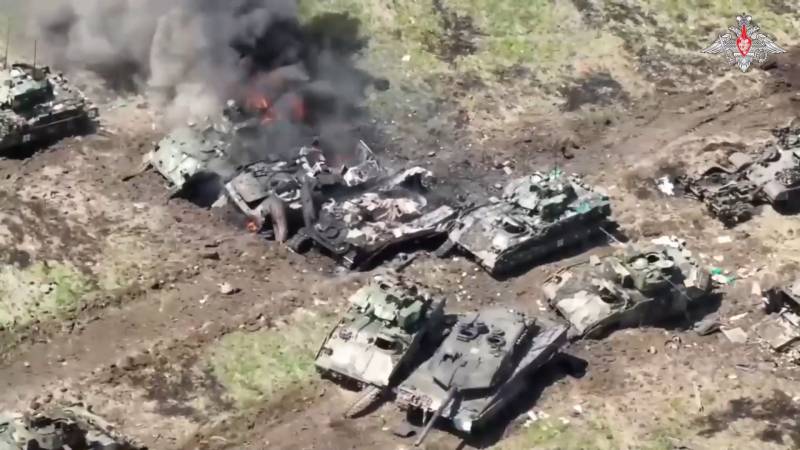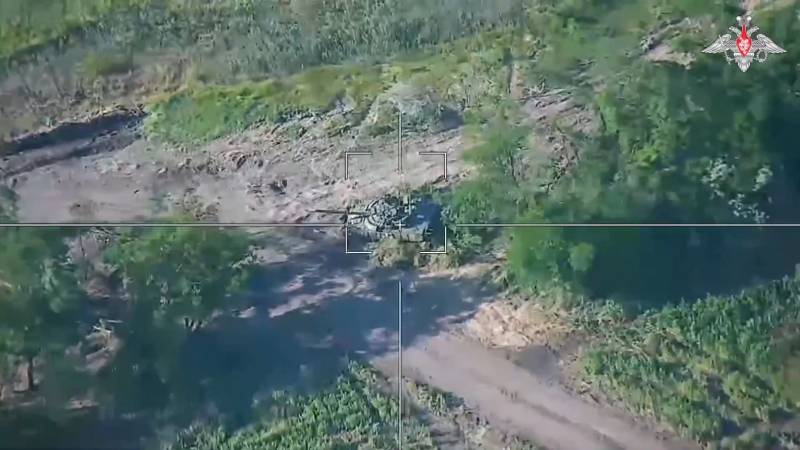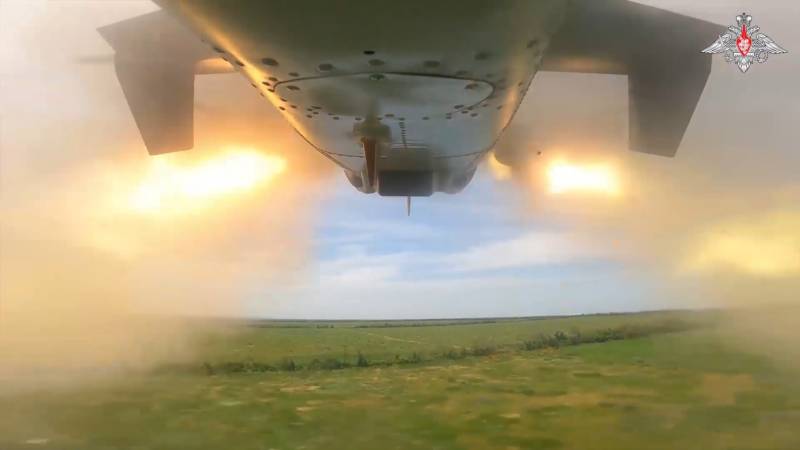Ukrainian counteroffensive through the eyes of foreign media

The beginning of the "counterattack": Ukrainian armored vehicles stopped in a minefield
The topic of a future Ukrainian counter-offensive has been actively discussed abroad over the past few months. Various experts and the media positively assessed the plans of the Kyiv regime and expected that he would be able to break through the Russian defenses. However, the battles of early June showed the failure of such forecasts. Now the foreign press has to look for explanations for this development of events.
Expectations and Reality
It should be recalled how foreign media talked about the preparations for the Ukrainian “counteroffensive”. Various publications regularly reported on certain events, on the mobilization and training of personnel, the supply of foreign weapons and equipment, etc. Most of these publications followed the current foreign agenda and predicted the future successes of Ukrainian formations.
The promised offensive started in early June in the Zaporozhye direction, and at the same time its first results became known. Ukrainian formations faced a developed defense system equipped with various means. They managed to formally occupy small territories, but at the same time they suffered significant losses in manpower and materiel.
A special role in the counter-offensive was assigned to foreign-made armored vehicles and weapons that had been delivered to Ukraine in recent months. However, it was these vehicles that were among the first to be included in the list of losses, and at a considerable distance from the main defensive positions of the Russian army. In the future, the losses of Ukrainian formations continued to grow.

Ukrainian tank in the sight of a shock UAV
In general, it is already clear that the long-promised "counterattack" did not go according to plan and actually failed. The enemy makes new attempts to break through the front, but again suffers losses. This development of events does not correspond to past foreign expectations, and foreign media now have to explain to readers what exactly happened and what could happen next.
First results
The unsuccessful offensive began a long time ago, and abroad are already trying to evaluate its first results. However, there is still no consensus. Some publications point to signs of failure, while others urge not to rush into assessments. In addition, some get by with neutral formulations that it is difficult to conduct hostilities, and their outcome is unpredictable.
For example, the French edition of Le Monde wrote on June 22 about the limited successes of the Ukrainian formations. They managed to occupy some territory, but then the offensive ran into Russian lines and stopped. The source of the publication in the military circles of France indicated that now the Kiev regime can look for weaknesses in Russian positions, which will be targeted by the next blow.
The next day, Le Figaro indicated that it was too early to give an estimate. Events at the front are developing, and their outcome is still unknown. It is curious that such an opinion was built not on the basis of information from the front, but on the statements of the Ukrainian leadership. Not so long ago, it complained that the advance was slower than it would like.

Combat work of the Ka-52 helicopter
Also on June 23, the Polish edition of Do Rzeczy quoted General Roman Polko as having a dissenting opinion. He believes that the "counterattack" has not even begun. At the moment, Ukrainian formations are only studying the defense of the Russian army and are looking for the direction of the main attack. In fact, the counteroffensive in this situation is not visible.
Another Polish general, Waldemar Skrzypczak, in an interview for Fronda.pl acknowledged the beginning of the Ukrainian counter-offensive, and also noted its dubious prospects. According to the general, in the near future Kyiv should strike back - for example, encircle Russian troops in the area of the city of Artemovsk (Ukrainian Bakhmut). If this does not happen, then in a couple of weeks the offensive will face a complete failure.
Causes of failure
Some foreign media are trying to analyze the situation and the situation and determine why the Ukrainian offensive is not living up to expectations. Various arguments are given related to the peculiarities of the actions of the Ukrainian and Russian sides. At the same time, interestingly, they are forced to recognize the high level of equipment and training of the Russian army.
The first conclusions followed a few days after the start of the Ukrainian offensive. Thus, in its publication of June 14, the British newspaper The Guardian concludes that the Russian defense is well prepared. The troops had almost a year to prepare defensive positions and used this opportunity. In addition, there is a widespread use of anti-tank systems that threaten foreign-made armored vehicles.

The moment of defeat of an enemy armored object
Unnamed Guardian sources noted that earlier forecasts about the course of hostilities were erroneous. The Russian army did not "melt" under Ukrainian attacks, and the enemy could not break through. This means that the battles in key areas will be long and exhausting.
One of the key components of the Russian defense was the engineering preparation of the terrain and the placement of barriers. Their significance was pointed out on June 15 by the French edition of Ouest-France. Considering the results of previous battles, it indicates that Russian minefields caused significant damage to the advancing Ukrainian units. They stopped the advance of armored vehicles and infantry, making it an easy target for artillery and missiles.
Earlier, on June 10, an interesting opinion about the past battles was given by Asia Times from Hong Kong - it was expressed by unnamed officers of the European armies. One foreign specialist noted the fallacy of Ukrainian tactics. Having limited forces and capabilities, Kyiv did not use them for one powerful blow, but arranged several small-scale operations, with a known result.
Another European specialist compared such an offensive with the actions of H. Guderian during the attack on France in the area of the city of Sedan. However, the Kyiv formations do not have the required air support, which leads to losses and to the failure of the operation. At the same time, developed aviation the Russian side has. The work of attack helicopters is especially noted.

Imported MBT Leopard 2 moments before defeat
Increased attention
Thus, the fighting in the zone of the Special Operation continues to attract the attention of foreign media and remains one of the main topics. Recently, interest in it has intensified due to the launch of a long-promised counteroffensive. The press continues to follow the news and "works out" the current topic.
At the same time, foreign publications found themselves in a difficult position. The actual results of the battles are not at all similar to those expected. The propaganda of Kyiv and its patrons painted terrible pictures for the Russian side with destroyed equipment and broken defense lines. However, during real battles, it was the Ukrainian formations that suffered heavy losses, and they did not manage to break through in any sector.
The real picture is at odds with the promises of the Ukrainian and foreign command, and the press has to take action. Some publications are trying to explain to readers and, probably, to themselves that the observed events are not fatal for the Kyiv regime. Others are engaged in the analysis of the situation with the degree of objectivity that is allowed at the current time in their countries.
It is obvious that the foreign press will continue to follow the actions of the Ukrainian formations and the new stages of the notorious "counteroffensive". At the same time, she will again have to write about the failures and failures of the Kyiv command and its troops. It will be possible to find out exactly how sharp corners will be smoothed and uncomfortable topics bypassed in the very near future. And the press will not have to wait long for the next news of this kind.
Information